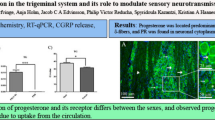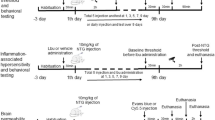Abstract
Background
Prostaglandins (PGs), particularly prostaglandin D2 (PGD2), E2 (PGE2), and I2 (PGI2), are considered to play a role in migraine pain. In humans, infusion of PGD2 causes lesser headache as compared to infusion of PGE2 and PGI2. Follow-up studies in rats have shown that infusion of PGE2 and PGI2 dilate the middle meningeal artery (MMA), and mRNA for PGE2 and PGI2 receptors is present in rat trigeminovascular system (TVS) and in the brain structures associated with pain. In the present study, we have characterized the dilatory effect of PGD2 on rat MMA and studied the relative mRNA expression of PGD2 receptors and lipocalin-type of PGD2 synthase (L-PGDS).
Method
Rat closed-cranial window (CCW) model was used to study the effect of the DP1 receptor antagonist, MK-0524, on PGD2-induced vasodilation of middle meningeal artery. The qPCR technique was used for mRNA expression analysis.
Results
PGD2 infusion evoked a dose-dependent dilation of the rat MMA. The calculated mean pED50 value was 5.23 ± 0.10 and Emax was 103 ± 18% (n = 5). MK-0524 significantly (∼61%, p < 0.05) blocked the PGD2-induced dilation of MMA. mRNA for the DP1, DP2 and L-PGDS were expressed differentially in all tested tissues. DP1 receptor mRNA was expressed maximally in trigeminal ganglion (TG) and in cervical dorsal root ganglion (DRG).
Conclusions
High expression of DP1 mRNA in the TG and DRG suggest that PGD2 might play a role in migraine pathophysiology. Activation of the DP1 receptor in MMA was mainly responsible for vasodilation induced by PGD2 infusion.
Similar content being viewed by others
References
Global, regional, and national incidence, prevalence, and years lived with disability for 301 acute and chronic diseases and injuries in 188 countries, 1990-2013: a systematic analysis for the global burden of disease study 2013. Lancet 2015;386:743–800.
Akerman S, Holland PR, Goadsby PJ. Diencephalic and brainstem mechanisms in migraine. Nat Rev Neurosci 2011;12:570–84.
Messlinger K, Lennerz JK, Eberhardt M, Fischer MJ. CGRP and NO in the trigeminal system: mechanisms and role in headache generation. Headache 2012;52(9):1411–27.
Olesen J, Burstein R, Ashina M, Tfelt-Hansen P. Origin of pain in migraine: evidence for peripheral sensitisation. Lancet Neurol 2009;8:679–90.
Lipton RB, Stewart WF, Ryan Jr RE, Saper J, Silberstein S, Sheftell F. Efficacy and safety of acetaminophen, aspirin, and caffeine in alleviating migraine headache pain: three double-blind, randomized, placebo-controlled trials. Arch Neurol 1998;55:210–7.
Vane JR. Inhibition of prostaglandin synthesis as a mechanism of action for aspirin-like drugs. Nat New Biol 1971;231:232–5.
Wienecke T, Olesen J, Oturai PS, Ashina M. Prostacyclin (epoprostenol) induces headache in healthy subjects. Pain 2008;139:106–16.
Wienecke T, Olesen J, Oturai PS, Ashina M. Prostaglandin E2 (PGE2) induces headache in healthy subjects. Cephalalgia 2009;29:509–19.
Wienecke T, Olesen J, Ashina M. Prostaglandin I2 (epoprostenol) triggers migraine-like attacks in migraineurs. Cephalalgia 2010;30:179–90.
Wienecke T, Olesen J, Ashina M. Discrepancy between strong cephalic arterial dilatation and mild headache caused by prostaglandin D2 (PGD2). Cephalalgia 2011;31:65–76.
Strassman AM, Raymond SA, Burstein R. Sensitization of meningeal sensory neurons and the origin of headaches. Nature 1996;384:560–4.
Jenkins DW, Feniuk W, Humphrey PPA. Characterization of the prostanoid receptor types involved in mediating calcitonin gene-related peptide release from cultured rat trigeminal neurones. Br J Pharmacol 2001;134:1296–302.
Myren M, Baun M, Ploug KB, Jansen-Olesen I, Olesen J, Gupta S. Functional and molecular characterization of prostaglandin E2 dilatory receptors in the rat craniovascular system in relevance to migraine. Cephalalgia 2010;30:1110–22.
Myren M, Olesen J, Gupta S. Pharmacological and expression profile of the prostaglandin I(2) receptor in the rat craniovascular system. Vascul Pharmacol 2011;55:50–8.
Myren M, Olesen J, Gupta S. Prostaglandin E2 receptor expression in the rat trigeminal-vascular system and other brain structures involved in pain. Neurosci Lett 2012;506:64–9.
Coleman RA, Smith WL, Narumiya S. International union of pharmacology classification of prostanoid receptors: properties, distribution, and structure of the receptors and their subtypes. Pharmacol Rev 1994;46:205–29.
Bos CL, Richel DJ, Ritsema T, Peppelenbosch MP, Versteeg HH. Prostanoids and prostanoid receptors in signal transduction. Int J Biochem Cell Biol 2004;36:1187–205.
Kanaoka Y, Urade Y. Hematopoietic prostaglandin D synthase. Prostaglandins Leukot Essent Fatty Acids 2003;69:163–7.
Gupta S, Bhatt DK, Boni LJ, Olesen J. Improvement of the closed cranial window model in rats by intracarotid infusion of signalling molecules implicated in migraine. Cephalalgia 2010;30:27–36.
Cheng K, Wu TJ, Wu KK, Sturino C, Metters K, Gottesdiener K, et al. Antagonism of the prostaglandin D2 receptor 1 suppresses nicotinic acid-induced vasodilation in mice and humans. Proc Natl Acad Sci U S A 2006;103:6682–7.
Chang SW, Reddy V, Pereira T, Dean BJ, Xia YQ, Seto C, et al. The pharmacokinetics and disposition of MK-0524, a prosglandin D2 receptor 1 antagonist, in rats, dogs and monkeys. Xenobiotica 2007;37:514–33.
Petersen KA, Dyrby L, Williamson D, Edvinsson L, Olesen J. Effect of hypotension and carbon dioxide changes in an improved genuine closed cranial window rat model. Cephalalgia 2005;25:23–9.
Ellis EF, Wei EP, Kontos HA. Vasodilation of cat cerebral arterioles by prostaglandins D2, E2, G2, and I2. Am J Physiol 1979;237:H381–85.
Morrow JD, Parsons III WG, Roberts LJ. Release of markedly increased quantities of prostaglandin D2 in vivo in humans following the administration of nicotinic acid. Prostaglandins 1989;38:263–74.
Lai E, De Lepeleire I, Crumley TM, Liu F, Wenning LA, Michiels N, et al. Suppression of niacin-induced vasodilation with an antagonist to prostaglandin D2 receptor subtype 1. Clin Pharmacol Ther 2007;81:849–57.
Hirai H, Tanaka K, Yoshie O, Ogawa K, Kenmotsu K, Takamori Y, et al. Prostaglandin D2 selectively induces chemotaxis in T helper type 2Cells, eosinophils, and basophils via seven-transmembrane receptor crth2. J Exp Med 2001;193:255–62.
Paternò R, Faraci FM, Heistad DD. Role of Ca2+-dependent K+ channels in cerebral vasodilatation induced by increases in cyclic GMP and cyclic AMP in the rat. Stroke 1996;27:1603–8.
Cheng K, Wu TJ, Wu KK, Sturino C, Metters K, Gottesdiener K, et al. Antagonism of the prostaglandin D2 receptor 1 suppresses nicotinic acid-induced vasodilation in mice and humans. Proc Natl Acad Sci U S A 2006;103:6682–7.
Ebersberger A, Averbeck B, Messlinger K, Reeh PW. Release of substance P, calcitonin gene-related peptide and prostaglandin E2 from rat dura mater encephali following electrical and chemical stimulation in vitro. Neuroscience 1999;89:901–7.
Noseda R, Burstein R. Migraine pathophysiology: anatomy of the trigeminovascular pathway and associated neurological symptoms, cortical spreading depression, sensitization, and modulation of pain. Pain 2013;154(Suppl. 1):S44–53.
Weiller C, May A, Limmroth V, Juptner M, Kaube H, Schayck RV, et al. Brain stem activation in spontaneous human migraine attacks. Nat Med 1995;1:658–60.
Alstadhaug KB. Migraine and the hypothalamus. Cephalalgia 2009;29:809–17.
Afridi SK, Giffin NJ, Kaube H. A positron emission tomographic study in spontaneous migraine. Arch Neurol 2005;62:1270–5.
Maleki N, Becerra L, Brawn J, McEwen B, Burstein R, Borsook D. Common hippocampal structural and functional changes in migraine. Brain Struct Funct 2013;218:903–12.
Moulton EA, Schmahmann JD, Becerra L, Borsook D. The cerebellum and pain: passive integrator or active participator. Brain Res Rev 2010;65:14–27.
Uddman R, Hara H, Edvinsson L. Neuronal pathways to the rat middle meningeal artery revealed by retrograde tracing and immunocytochemistry. J Auton Nerv Syst 1989;26:69–75.
Arbab MA, Wiklund L, Svendgaard NA. Origin and distribution of cerebral vascular innervation from superior cervical, trigeminal and spinal ganglia investigated with retrograde and anterograde WGA-HRP tracing in the rat. Neuroscience 1986;19:695–708.
Mainero C, Boshyan J, Hadjikhani N. Altered functional magnetic resonance imaging resting-state connectivity in periaqueductal gray networks in migraine. Ann Neurol 2011;70:838–45.
Coppola G, Schoenen J. Cortical excitability in chronic migraine. Curr Pain Headache Rep 2012;16:93–100.
Urade Y, Kitahama K, Ohishi H, Kaneko T, Mizuno N, Hayaishi O. Dominant expression of mRNA for prostaglandin D synthase in leptomeninges, choroid plexus, and oligodendrocytes of the adult rat brain. Proc Natl Acad Sci U S A 1993;90:9070–4.
Gerashchenko D, Beuckmann CT, Kanaoka Y, Eguchi N, Gordon WC, Urade Y, et al. Dominant expression of rat prostanoid DP receptor mRNA in leptomeninges, inner segments of photoreceptor cells, Iris epithelium, and ciliary processes. J Neurochem 1998;71:937–45.
Liang X, Wu L, Hand T, Andreasson K. Prostaglandin D2 mediates neuronal protection via the DP1 receptor. J Neurochem 2005;92:477–86.
Myren M, Ramachandran R, Amrutkar D, Hay-Schmidt A, Jansen-Olesen I, Gupta S, et al. Expression, localization and neuro-modulatory properties of the IP receptor in migraine relevant tissues. Cephalalgia 2013;8(Suppl. 8):241.
Eguchi N, Minami T, Shirafuji N, Kanaoka Y, Tanaka T, Nagata A, et al. Lack of tactile pain (allodynia) in lipocalin-type prostaglandin D synthase-deficient mice. Proc Natl Acad Sci U S A 1999;96:726–30.
Author information
Authors and Affiliations
Corresponding author
Rights and permissions
About this article
Cite this article
Sekeroglu, A., Jacobsen, J.M., Jansen-Olesen, I. et al. Effect of PGD2 on middle meningeal artery and mRNA expression profile of L-PGD2 synthase and DP receptors in trigeminovascular system and other pain processing structures in rat brain. Pharmacol. Rep 69, 50–56 (2017). https://doi.org/10.1016/j.pharep.2016.09.015
Received:
Revised:
Accepted:
Published:
Issue Date:
DOI: https://doi.org/10.1016/j.pharep.2016.09.015




